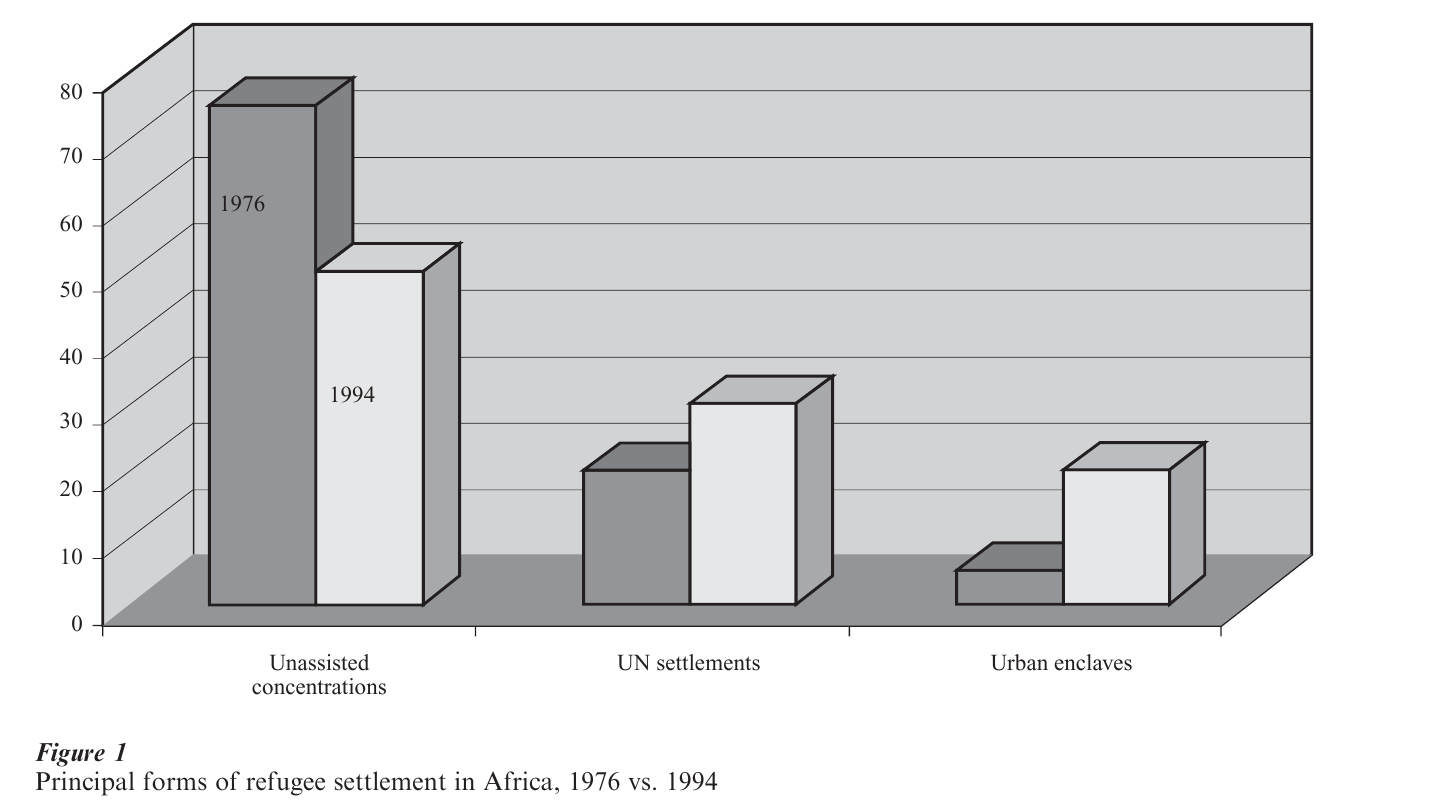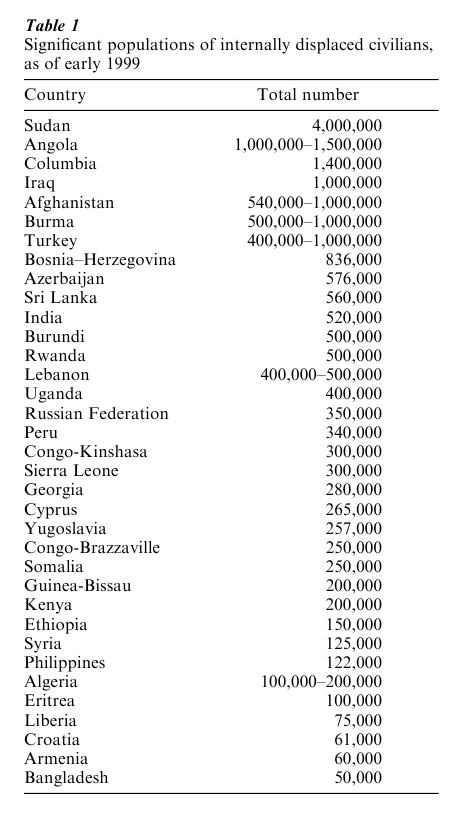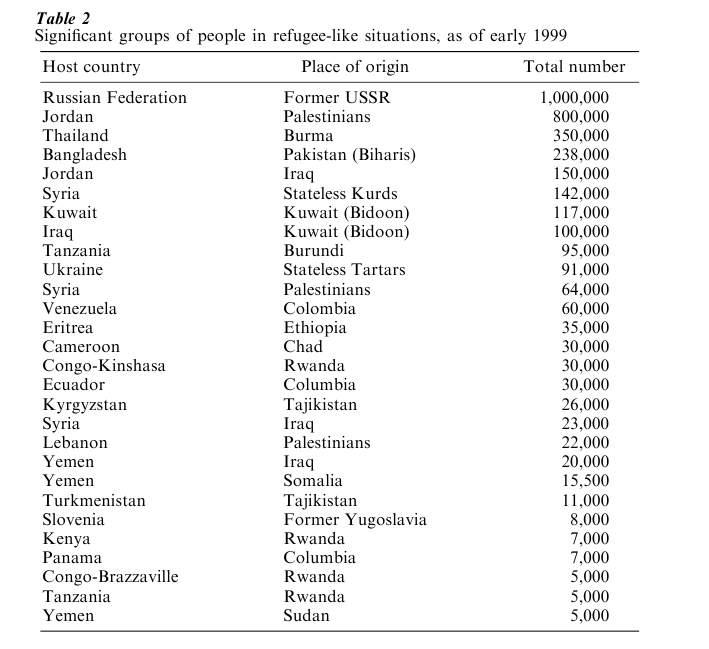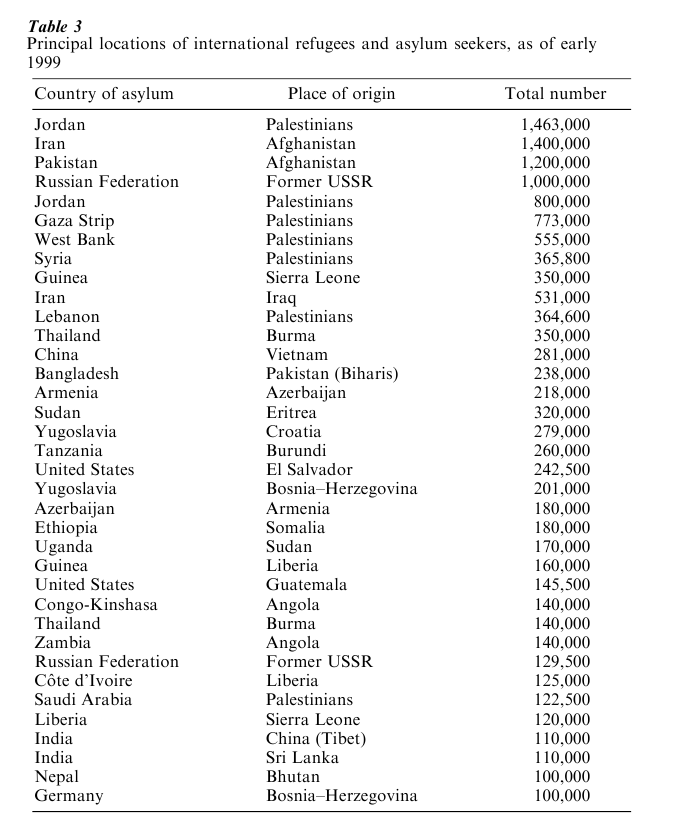Sample Geographical Aspects of Refugees Research Paper. Browse other research paper examples and check the list of research paper topics for more inspiration. iResearchNet offers academic assignment help for students all over the world: writing from scratch, editing, proofreading, problem solving, from essays to dissertations, from humanities to STEM. We offer full confidentiality, safe payment, originality, and money-back guarantee. Secure your academic success with our risk-free services.
Migrants are commonly differentiated based on their motivation for moving. The term ‘refugee’ is used to denote an individual who is forced flee in search of safety in contrast to someone who chooses of their own accord to relocate, i.e., a voluntary migrant. This research paper examines geographical aspects of forced migration, a condition that applies to more than 34 million of the estimated 100 million permanent migrants worldwide.
Academic Writing, Editing, Proofreading, And Problem Solving Services
Get 10% OFF with 24START discount code
1. The Term ‘Refugee’
Legal distinctions regarding refugees can be traced to the United Nations Conference on the Status of Refugees and Stateless Persons. Article 1 of the 1951 Geneva Convention Relating to the Status of Refugees applied the term to
[Any person who] … owing to a well-founded fear of persecution for reasons of race, religion, nationality, membership of a particular social group, or political opinion is forced to migrate involuntarily across an international boundary and remain outside his country of nationality.
Cause, motive, and political boundary thus became the classic benchmark determiners of refugee status. The 1951 Refugee Convention specifically addressed the status of Europeans displaced by WWII.
An amended 1967 Protocol established legal standards for refugees in all world regions at any time. Although the 133 signatories are not required to provide asylum to refugees, they are prohibited against refoulement—expelling or returning refugees to countries where their life or freedom would be threatened (Hamilton 1999).
Under international law, final authority to grant refugee status rests in the hands of a given host government. Practically speaking, however, a branch of the United Nations bears the primary task of protecting refugees. In 1951, the UN General Assembly created the Office of the United Nations High Commissioner for Refugees with a brief three-year life span in mind. In 1954, however, the Assembly extended UNHCR’s mandate for another five years. Successive five-year renewals have followed ever since.
Headquartered in Geneva, UNHCR is charged with refugee protection and the promotion of lasting solutions to their displacement. According to its statute, UNHCR is competent to assist:
[Any person who] … owing to well founded fear of being persecuted for reasons of race, religion, nationality, or political opinion, is outside the country of his nationality and is unable or, owing to such fear or for reasons other than personal convenience, is unwilling to avail himself of the protection of that country; or who, not having a nationality and being outside the country of his former habitual residence, is unable or, owing to such fear or for reasons other than personal convenience, is unwilling to return to it (UNHCR 1993).
Protection remains UNHCR’s raison d’etre, but the complexities of post-Cold War conflicts have forced the agency to broaden its scope considerably. Whereas the Office of the United Nations High Commissioner for Refugees once restricted its concern to people outside their country of origin, it has become increasingly involved in assisting and protecting returnees who repatriate to their home countries as well as groups of people who face refugee-like situations within their country of origin (UNHCR 1993). As the dimensions and dynamics of forced migration change so the term ‘refugee’ has come to apply to other forms of displacement. The discussion to follow examines ‘classic’ international refugees who cross a political boundary and then, several types of ‘internal’ refugees.
1.1 International Refugees
Although geographers, starting with Ravenstein’s work in the late 1800s, have long studied voluntary migration, their analysis of forced migration lagged far behind. At the 1950 meetings of the Association of American Geographers, Proudfoot introduced a ninefold categorization of refugee population. That paper constitutes an early example of geographic work on the specific topic of refugees. Geographers thus began documenting the flight and distribution of specific refugee populations, and, they have continued to do so ever since.
Kunz (1973) offered a set of conceptual postulates structured around the dimensions of space and time. That a sociologist provided the model of refugee flight patterns reflected that fact that geographers still gave limited attention to forced migration. In 1977, an article published in The Professional Geographer summarized the state of the refugee literature. Rogge concluded that geographers had produced a considerable volume of literature on human mobility, but that ‘ … one form of mobility, however, namely the forced or impelled migration of refugees, has received only peripheral attention by the discipline.’
Refugee research, including that of geographers, has grown substantially during the last 25 years (Hyndman 1999). Refugee study programs now exist at universities in Canada, Egypt, Great Britain, Kenya, Sweden, and the United States. Academic interest has correlated with the growing magnitude of refugee crises worldwide wherein the global total grew from less than 3.5 million in 1977 to a peak point of 18.2 million in 1992 (UNHCR 1993). Although media coverage tends to reinforce the perception that all refugees are in camps, most refugees—at least in the case of Africa—are still more likely to reside outside UN settlements (see Fig. 1).

During the 1980s, refugee research largely focused on the first and second stages of the refugee experience —the processes of flight and resettlement. Resettled Central Americans and Indochinese in the United States were the focus of study in the context of more developed countries. That East Africa had become the epicenter of refugee crisis in the developing world was reflected in books on Eritrean and Ugandan resettlement (see Rogge 1985, Harrell-Bond 1986, and Bulcha 1988). A basic distinction was frequently made between assisted refugees housed in UN-sanctioned camps or settlements and unassisted refugees who either self-settled in rural areas or in urban centers (Wijbrandi 1990).
In 1990, the locus of the global refugee population was predominantly in the global South. Developing countries hosted nearly 97 percent of all refugees. Conflicts in Afghanistan, Ethiopia, and Mozambique produced populations that each numbered in the millions apiece. The Palestinian community (2.48 million) had long since become permanent stateless exiles dispersed throughout the Middle East. Together, these four groups accounted for more than 13 million of the 16.6 million refugees worldwide. Yet, refugees could be found among more than one hundred different countries. And exile periods were extending longer and longer.
During the decade of the 1990s, geographers diversified their approach to match the growing complexities of the refugee picture worldwide (Black 1991 and Black and Robinson 1993). Refugee settlement was treated less and less often as if it were a self-contained process in isolation, thus moving beyond a ‘refugeecentric’ perspective (Chambers 1986). Bascom (1993), for example, related the larger processes of rural transformation and agrarian change to that of refugee settlement. Although media images give the impression that refugees are mass ‘flows,’ it became abundantly clear that ethnic, age, gender, and class differentiation all exist among uprooted populations (Bascom 1998).
Repatriation became a ‘lead’ research theme in the 1990s (Wood 1989 and Allen and Morsink 1994). As early as 1984, UNHCR had identified repatriation as one of three ‘durable’ solutions for refugees. The de facto solution is long-term integration of refugees in the country of first asylum. The exceptional solution, reserved for only a small percentage of asylum applicants, is resettlement to a third country of asylum. The optimum solution of the three is repatriation—the return migration of refugees from exile to their homeland. The UN High Commissioner for Refugees proclaimed the 1990s as the ‘decade of repatriation.’
Repatriation research focused first on legal or logistical matters, then shifted to the socioeconomic and psychological dimensions of repatriations (Rogge 1991). Mozambique, Eritrea, and Afghanistan were some of the principal countries of concern. In theory, the repatriation decision is meant to be voluntary, fully informed, and only to occur when the conditions that prompted flight no longer exist. Practically, however, repatriations can involve different scenarios such as refugees choosing to return despite ongoing conflict or being forced to return home by host governments. Forced deportation, or refoulement, of refugees is the worst possible violation of the 1951 Refugee Convention.
The face of refugee studies changed dramatically during the last decade of the twentieth century. It began with the dissolution of the Soviet Union, whose fragmentation prefigured a pattern to come; states under siege amid competing national interests and thus producing complicated flows and counter-flows of displaced people. Wars in the Persian Gulf and Yugoslavia spiked the refugee total up to its record high. The year of 1994 marked the largest and fastest exodus in the modern history of refugee migration. More than 250,000 Rwandans fled the country in only 24 hours. Yet the era of mass movement across discrete political boundaries was already giving way to more ‘complex humanitarian emergencies’ (Hyndman 1999).
The painful saga of intervention in Somalia followed by the Rwandan debacle have made the international community increasingly aware of the relationship of refugees to peacekeeping, peacemaking, political stability, and humanitarian action. The UN began emphasizing the need to:
(a) incite and expedite conflict resolution in source countries so refugees can return,
(b) take vigorous action—including emergency response to crises and the provision of international protection on site—to eradicate the causes of flight before refugees flee, and
(c) initiate more proactive intervention to prevent the development of conditions that might impel people to leave in the first place (UNHCR 1993).
The United Nations forged cross-mandate approaches to refugee crises. In the case of Somalia and Mozambique, for example, UNHCR sought collaboration with governments, the UN Department of Humanitarian Affairs (DHA), other concerned United Nations agencies, and NGOs to establish means of protection and assistance for all affected populations, i.e., returnees, internally displaced persons and other impoverished nationals. UNHCR has also increased assistance for refugees outside formal camps and settlements as well as to local populations in resettlement areas.
Meanwhile, the balance of the globe’s refugee population began to swing toward Europe. People had come to think of refugees as a Third World problem, but the shattering of Yugoslavia forced Europeans and North Americans to engage with refugees much more directly. First, warfare sites moved closer. Then refugees turned to neighboring countries for protection, assistance, and asylum. And the need for political stability in southern Europe as well as ethnic links to Bosnians, Croatians, Slovenians, and Serbs could not be ignored. Whereas Europeans and North Americans enjoyed the luxury of modest refugee resettlement programs during the 1980s, they were inundated with asylum requests during the 1990s. The United States, Canada, and 17 European nations all received refugees from Bosnia. Meanwhile, the plight of Kurds entrapped within Iraq initiated a new debate about ‘internal refugees.’
1.2 Internal Refugees
During the 1980s and 1990s, the character of war shifted in balance from conflict between sovereign states to civil conflict. International refugees now represent the smaller portion of the globe’s displaced population. Internally displaced persons (20 million) outrank the number of ‘classic’ refugees—asylum seekers who have involuntarily crossed an international boundary and remain outside their country of nationality. Sudan (4 million) tops the list of countries with large numbers of civilians displaced by persecution or armed conflict (see Table 1).

‘Internal refugees,’ more commonly known as internally displaced persons (IDPs), became a central focus of refugee research (see Bennett 1998, Cohen and Deng 1998, and Hampton 1998). In 1999, the IDP table in the World Refugee Survey included 41 countries as compared to only 25 in 1990. IDP growth reflects the pandemic of civil conflict as well as paramilitary activity in settings of chronic social anarchy like Somalia and Columbia. Most IDPs are refugees in every respect except that they have not, or, cannot cross an international boundary. Although civilians are more frequently targeted as a deliberate tactic of war, they have no right to protection or humanitarian assistance as long as they remain inside their countries. Estimates of the number of internally displaced persons are often fragmentary and unreliable because they remain largely inaccessible to outside monitors and non-governmental relief organizations (Hamilton 1999). The total number of IDPs may be much higher than 17 million.
‘Internal refugees’ have become a central policy concern. In 1992, the secretary-general of the UN appointed a Representative on Internally Displaced Persons. Representative Francis Deng continues to parlay the status associated with his title into a limited protection framework for IDPs. The current working definition of IDP is that of a:
Person or group of people who have been forced to flee or to leave their homes or places of habitual residence as a result of, or in order to avoid, in particular, the effects of armed conflict, situations of generalized violence, violations of human rights or natural or human-made disasters, and who have not crossed an internationally recognized border (Bennett 1998).
Clearly, the locus of concern is limited to those forcibly uprooted within a given national territory. The working definition is broadly inclusive, combining several forms of internal migration, which can also be are treated as separate entities.
Most IDPs are forced to move due to explicit forms of persecution or armed conflict, but others migrate because of natural or man-made disasters. Victims of clear-cut natural catastrophes such as a hurricane in Honduras, massive mud slides in Venezuela, or repeated earthquakes in Turkey are sometimes referred to as ‘environmental refugees.’ Yet, famine-induced migrations often involve man-made factors. Drought, for example, was the immediate, observable cause of large population movements in Ethiopia and Sudan during 1984 and 1985. Poor rainfall may have prompted flight, but displacement within Ethiopia was amplified by the deliberate obstruction of food aid into stricken areas. In Sudan, more than 100,000 people left their homes. Largely at fault was the structure of the Sudanese political economy that set the stage for migration out of rural regions. For many who left, migration was but the culmination of an impoverishment process associated with the appropriation of labor and land by mechanized agricultural schemes, obstructionist tactics employed by merchants, and the state’s long-term neglect of the rural sector. The flight of ‘environmental refugees’ like these is a symptomatic manifestation of oppressive economic and political conditions.
Two other forms of forced migration bear mention —migrants in refugee-like conditions and development-induced displacement. In its highly regarded annual World Refugee Survey, the US Committee for Refugees, a public information program of Immigration and Refugee Services of America, reserves a separate table entitled ‘For people in refugee-like conditions’ (see Hamilton 1999 and Table 2). The 1999 report identifies more than 3.5 million such persons found within 28 countries. Some of these refugee-like people are stateless, denied the protection afforded by citizenship, e.g., Kurds in Syria or Tartars in Ukraine. Others are regarded by host governments as illegal aliens, or simply tolerated, or ignored (Hamilton 1999). Development-induced displacement is a final form of forced migration. Revolutionary governments in China and Ethiopia launched ambitious development programs that required resettlement of hundreds of thousands of people, some voluntarily, many not. Today in China, work continues on the largest dam resettlement project in history. Thus far, more than 1.2 million persons have been displaced in the wake of the Three Gorges Dam project.

2. Future Directions
At the end of the 1990s, the locus of the world’s refugee population remained predominantly in the South, but 2.38 million of the world’s 13.4 million refugees (18 percent) are settled in the First World. Although the total number of refugees has decreased since 1992, the number of countries that host asylum-seekers increased to 125. Many countries host refugees from several countries simultaneously; thus 161 different populations of exiled refugees exist worldwide. Palestinians (3.8 million) and Afghans (2.6 million) still constitute the two largest refugee communities (see Table 3). Iraq, Sierra Leone, Bosnia and Herzegovina, Somalia, Sudan, Eritrea, Liberia, Croatia, Angola, Burundi, Vietnam, and El Salvador are also important source countries. At least 250,000 citizens from each one have fled into exile. Meanwhile, migration policies are tightening in Europe and North America. Geo-policing of migration poses new challenges to refugees who desire asylum and permanent residence in fortress Europe. In addition, the United States has placed some of the most severe restrictions on asylum procedures in its history.

Contemporary refugee flows are subject to far more complexity than prevailed in the earlier European context of World War II. The case of the Kurdish population entrapped within Iraq initiated a new debate about human rights, national sovereignty, and new modalities for international intervention. Massive upheaval in Kosovo and NATO’s unprecedented level of intervention intensified the debate further. ‘Safe havens’ for Iraqi Kurds, ‘zones of tranquility’ for returning Afghan refugees, ‘open relief centers’ for would-be Sri Lankan refugees, and ‘safe corridors’ to Muslim enclaves in Bosnia exemplify ‘new’ spaces and discourses associated with refugees (Hyndman 1999). Social scientists face major challenges and opportunities on many fronts. Longitudinal studies are needed to trace the refugee experience and associated processes through the ‘full circle’ of flight, resettlement, repatriation, and reintegration. The fourth stage of the refugee cycle—reintegration of former refugees after their return home – is especially in need of analysis. The use of remote sensing is a promising new research technique that geographers have begun employing to document displacement and to monitor environmental degradation around refugee sites (see Lodhi et al. 1998 and Bjorgo 2000). ‘Refugeeism,’ diaspora experiences, ethnic identity, de-territorialization, post-colonial expressions of place, and sense of home are important refugee related themes that social theorists in geography are well equipped to address.
The era of discrete refugee definitions is over. The traditional distinction between the refugee and voluntary migrant continues to be eroded in the face of new human dramas and political controversies. One need look no farther than the recent case of a Cuban six-year old rescued after his mother died in search of asylum or that of Chinese stowaways in container ships bound for America.
Bibliography:
- Allen T, Morsink H (eds.) 1994 When Refugees Go Home. Africa World Press, Trenton, NJ
- Bascom J 1993 The peasant economy of refugee resettlement in eastern Sudan. Annals of the Association of American Geographers 83: 320–46
- Bascom J 1998 Losing Place: Refugee Populations and Rural Transformations in East Africa. Berghahn Press, New York
- Bennett J 1998 Forced migration within national borders: The IDP agenda. Forced Migration Review 1: 4–6
- Bjorgo E 2000 Using very high resolution multispectral sensor imagery to monitor refugee camps. International Journal of Remote Sensing 21: 611–16
- Black R 1991 Refugees and displaced persons: Geographical perspectives and research directions. Progress in Human Geography 15: 281–98
- Black R, Robinson V (eds.) 1993 Geography and Refugees: Patterns and Processes of Change. Belhaven Press, London
- Bulcha M 1988 Flight and Integration: Causes of Mass Exodus from Ethiopia and Problems of Integration in the Sudan. Scandinavian Institute of African Studies, Uppsala, Sweden
- Chambers R 1986 Hidden losers? The impact of rural refugee programs on poorer hosts. International Migration Review 20: 245–63
- Cohen R, Deng F (eds.) 1998 The Forsaken People: Case Studies of the Internally Displaced. The Brookings Institution, Washington, DC
- Hamilton V 1999 The 1999 World Refugee Survey. US Committee for Refugees, Washington, DC
- Hampton J (ed.) 1998 Internally Displaced People: A Global Survey. Earthscan, London
- Harrell-Bond B 1986 Imposing Aid: Emergency Assistance to Refugees. Oxford University Press, London
- Hyndman J 1999 A post-cold war geography of forced migration in Kenya and Somalia. The Professional Geographer 51: 104–14
- Kunz E 1973 The refugee in flight: Kinetic models and forms of displacement. International Migration Review 7: 125–46
- Lodhi M, Echavarria F, Keithley C 1998 Using remote sensing data to monitor land cover changes near Afghan refugee camps in northern Pakistan. Geo-Carto International 13: 33–40
- Rogge J 1977 A geography of refugees: Some illustrations from Africa. Professional Geographer 29: 186–9
- Rogge J 1985 Too Many, Too Long: Sudan’s Twenty-year Refugee Dilemma. Rowman and Littlefield, Totowa, NJ
- Rogge J 1991 Repatriation of refugees: A not-so-simple ‘optimum’ solution. In: Allen T, Morsink H (eds.) When Refugees Go Home. Africa World Press, Trenton, NJ
- UNHCR 1993 The State of the World’s Refugees 1993: The Challenge of Protection. Penguin, New York
- Wijbrandi J 1990 Organized and spontaneous settlement. In: Khulman T, Tieleman H (eds.) Enduring Crisis: Refugee Problems in Eastern Sudan. African Studies Centre, Lieden, The Netherlands
- Wood W 1989 Long time coming: The repatriation of Afghan refugees. Annals of the Association of American Geographers 79: 345–69




